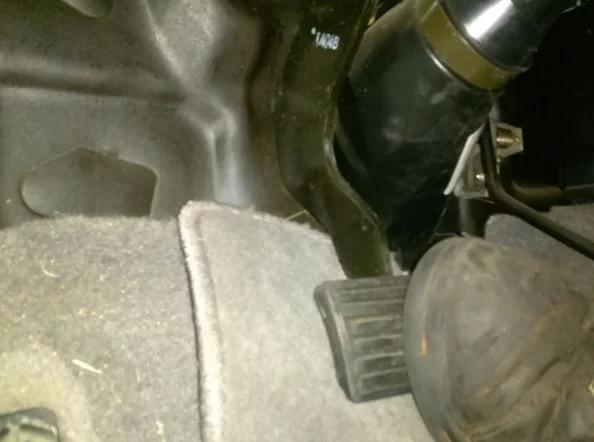Have you ever pressed your brake pedal and felt like it sank into the floor, like stepping into a giant marshmallow? Or perhaps you noticed it didn’t feel firm, but rather, alarmingly soft and squishy? This sensation, known as a “spongy” brake pedal, is a common problem that can be deeply worrying for drivers. It often signals a problem with your brake system, which can be a serious safety concern. Understanding why your brake pedal feels like a marshmallow is crucial for staying safe on the road.

Image: viewfloor.co
Think about the peace of mind you get when you know your brakes are working perfectly. You’re confident knowing you can stop safely in any situation. But when you experience a spongy brake pedal, that confidence erodes. This article will demystify the problem, guiding you to understand the potential causes and how to address this issue effectively.
What Causes a Spongy Brake Pedal?
A spongy brake pedal is often a symptom of a problem within your braking system. Here’s a breakdown of some of the most common causes:
-
Air in the Brake Lines: When air gets into your brake lines, it compresses under pressure, making the pedal feel soft and spongy. This is a relatively common problem, especially after brake work has been done. Air can enter your system through a number of ways, including:
- Improper Bleeding – Bleeding the brakes involves removing air from the brake lines during fluid changes or repairs. If this isn’t done correctly, air can remain trapped, leading to a spongy pedal.
- Leaking Brake Lines – A leak allows air to enter the system, causing a loss of pressure and resulting in a mushy brake pedal.
-
Worn Brake Pads or Shoes: Your brake pads and shoes are responsible for creating friction when you brake. As they wear down, they lose their effectiveness and you may notice a spongy feeling in the pedal.
-
Fluid Contamination: Brake fluid is hygroscopic, meaning it attracts moisture. Over time, moisture can contaminate the brake fluid, reducing its boiling point and causing it to become less effective. This can lead to a spongy pedal, particularly in hot conditions.
-
Faulty Master Cylinder: The master cylinder is the heart of your brake system, transferring pressure from your foot to the brake calipers. A faulty master cylinder can leak fluid, allow air to enter the lines, or even fail completely, all of which contribute to a spongy brake pedal.
-
Worn or Leaking Brake Calipers – Brake calipers house the pistons that push the brake pads against the rotors or drums. Worn or leaking calipers can lead to poor brake performance and a spongy pedal.
Diagnosing the Problem
Identifying the root cause of your spongy brake pedal is crucial for getting it fixed. Consider these steps for diagnosis:
-
Check the Brake Fluid Level: The first step is to check the level of brake fluid in your master cylinder reservoir. If the fluid level is low, it may indicate a leak in the system.
-
Look for Leaks: Inspect your brake lines, calipers, and master cylinder for any leaks. Look for signs of fluid dripping or staining.
-
Feel the Pedal: With the engine running, pump the brake pedal several times. Does the pedal feel spongy, or does it firm up after a few pumps? If the pedal is spongy but firms up, it likely means there’s air in the brake lines. A consistently spongy pedal may indicate a more serious problem, such as a faulty master cylinder.
-
Test the Brakes: Once you’ve identified a possible cause, test the brakes carefully. Always prioritize safety. If the spongy pedal is accompanied by other symptoms, such as a grinding noise or a pulling sensation, don’t drive the car until it’s been inspected by a qualified mechanic.
Taking Action
If you’re experiencing a spongy brake pedal, it’s essential to take action:
-
Don’t Ignore the Problem: A spongy brake pedal is a serious safety concern. Don’t drive your car with this issue. It’s better to be safe than sorry!
-
Seek Professional Help: The best course of action is to have your brakes inspected by a qualified mechanic. They can diagnose the problem and recommend the appropriate repairs.
-
Regular Brake Maintenance: Routine brake maintenance can help prevent a spongy brake pedal from ever becoming a problem. Have your brake pads, shoes, and fluid inspected regularly, and replace them as needed.

Image: dragonball-pics1.blogspot.com
Preventing Future Problems
Taking preventative measures can help minimize the chances of encountering a spongy brake pedal in the future. Here are some tips:
-
Check Your Fluid Level: Regularly check the brake fluid level in the master cylinder reservoir. It should be between the “min” and “max” marks. If the fluid level is low, have it checked by a mechanic.
-
Choose Quality Brake Fluid: When replacing your brake fluid, use DOT 3 or DOT 4 fluid. DOT 3 is more common and more affordable, while DOT 4 has a higher boiling point and is suitable for higher-performance vehicles.
-
Don’t Over-tighten Brake Lines: When working on your brake system, don’t over-tighten the brake lines. This can cause them to weaken and eventually crack or leak.
-
Regular Brake Inspections: Schedule regular brake inspections with a qualified mechanic. This ensures your brakes are always in top condition and helps prevent major issues from developing.
Brake Pedal Spongy And Slowly Goes To Floor
The Takeaway
A spongy brake pedal is often a sign of a problem in your braking system, a system critical to your safety on the road. Understanding the causes behind a spongy brake pedal, taking the appropriate actions, and practicing preventative maintenance can help ensure that you and your passengers are safe. Don’t delay your brakes – a trip to a mechanic could save your life. Remember, it’s always better to be safe than sorry.





